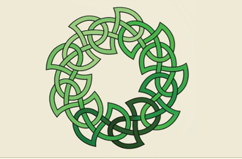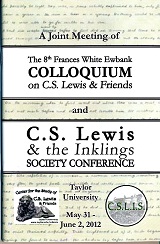Event Title
Academic Paper Session 3-C
Location
Smith-Hermanson 151
Start Date
1-6-2012 2:00 PM
Description
"A Meaningful Hierarchy: How C.S. Lewis Perceives Humanity's Significance" - Zachary A. Rhone
"Humans are amphibians -- half spirit and half animal," writes Screwtape. In Mere Christianity, C.S. Lewis would clarify these halves as the Bios and the Zoe -- the biological and the spiritual, respectively. Humans are, as Dr. Ransom admits in That Hideous Strength, "More. But not less" than animals, yet humanity's Fall resulted from "the idea that they could 'be like gods' -- could set up on their own as if they had created themselves -- be their own masters -- invent some sort of happiness for themselves outside God, apart from God" (MC). Humans are placed above animals yet below the divine. Lewis, like his fellow authors, points to these paradoxes as the heart of humanity's significance -- that is, humanity should be not only the masters of the beasts but also the mastered of the divine. As Ransom aptly states," We are now as we ought to be -- between the angels who are our elder brothers and the beasts who are our jesters, servants and playfellows." This presentation discusses how humanity, in Lewis' worldview, must accept its place in the hierarchy of the universe in order to find significance, for, as G.K. Chesterton remarks in The Everlasting Man, humanity is "the measure of all things."
"C.S. Lewis and the Angelic Hierarchy" - Susan and Woody Wendling
After describing the belief in the Angelic Hierarchy as central to ancient "spiritual cosmology," both Scriptural and Neoplatonic, this paper identifies Lewis's fascination with it in both his fiction (the Ransom trilogy) and his nonfiction (The Oxford History of English Literature in the 16th Century excluding Drama and The Discarded Image). Often viewed by Moderns as a "mythological hangover from pre-Modern times," belief in the Angelic Hierarchy is a key component of what Lewis calls "the Discarded Image." For those tempted to think that Lewis's interest in the Angelic Hierarchy was merely love for the beauty of the "old model," or else merely the mythic backdrop of his fictional "Random trilogy," this paper reveals Lewis's actual personal belief in the reality of the Angelic Hierarchy: the fact that God "comes filtered to us" through the hierarchies of angelic spiritual beings. Lewis's essay The Empty Universe reveals that the ancient "spiritual cosmology" has been increasingly replaced with a "modern" materialist worldview, leading not only to the "dryads leaving the trees" but also ultimately to the "abolition of man."
"From Versailles to Verneuil: The Shaping of Dorothy L. Sayers" - Crystal Downing
Briefly paralleling the lives of Lewis, Tolkien, and Sayers, this paper proceeds to discuss the year Dorothy L. Sayers spent working in France: 1919-20. Under theorized in Sayers scholarship, this year in Normandy dramatically shaped Sayer's life and publication history providing not only her first encounter with unwanted pregnancy, but also her increasing interest in detective fiction and her first glimmers about a theology of "good work well done." Her year in Verneuil-sur-Avre, I argue, provided the scaffolding from which Sayers eventually constructed her theory of the imago Dei, establishing God as Master Architect.
Event Type
Paper
Link to Papers
A Meaningful Hierarchy: How C.S. Lewis Perceives Humanity's Significance
C.S. Lewis and the Angelic Hierarchy
From Versailles to Verneuil: The Shaping of Dorothy L. Sayers (Not available)
Academic Paper Session 3-C
Smith-Hermanson 151
"A Meaningful Hierarchy: How C.S. Lewis Perceives Humanity's Significance" - Zachary A. Rhone
"Humans are amphibians -- half spirit and half animal," writes Screwtape. In Mere Christianity, C.S. Lewis would clarify these halves as the Bios and the Zoe -- the biological and the spiritual, respectively. Humans are, as Dr. Ransom admits in That Hideous Strength, "More. But not less" than animals, yet humanity's Fall resulted from "the idea that they could 'be like gods' -- could set up on their own as if they had created themselves -- be their own masters -- invent some sort of happiness for themselves outside God, apart from God" (MC). Humans are placed above animals yet below the divine. Lewis, like his fellow authors, points to these paradoxes as the heart of humanity's significance -- that is, humanity should be not only the masters of the beasts but also the mastered of the divine. As Ransom aptly states," We are now as we ought to be -- between the angels who are our elder brothers and the beasts who are our jesters, servants and playfellows." This presentation discusses how humanity, in Lewis' worldview, must accept its place in the hierarchy of the universe in order to find significance, for, as G.K. Chesterton remarks in The Everlasting Man, humanity is "the measure of all things."
"C.S. Lewis and the Angelic Hierarchy" - Susan and Woody Wendling
After describing the belief in the Angelic Hierarchy as central to ancient "spiritual cosmology," both Scriptural and Neoplatonic, this paper identifies Lewis's fascination with it in both his fiction (the Ransom trilogy) and his nonfiction (The Oxford History of English Literature in the 16th Century excluding Drama and The Discarded Image). Often viewed by Moderns as a "mythological hangover from pre-Modern times," belief in the Angelic Hierarchy is a key component of what Lewis calls "the Discarded Image." For those tempted to think that Lewis's interest in the Angelic Hierarchy was merely love for the beauty of the "old model," or else merely the mythic backdrop of his fictional "Random trilogy," this paper reveals Lewis's actual personal belief in the reality of the Angelic Hierarchy: the fact that God "comes filtered to us" through the hierarchies of angelic spiritual beings. Lewis's essay The Empty Universe reveals that the ancient "spiritual cosmology" has been increasingly replaced with a "modern" materialist worldview, leading not only to the "dryads leaving the trees" but also ultimately to the "abolition of man."
"From Versailles to Verneuil: The Shaping of Dorothy L. Sayers" - Crystal Downing
Briefly paralleling the lives of Lewis, Tolkien, and Sayers, this paper proceeds to discuss the year Dorothy L. Sayers spent working in France: 1919-20. Under theorized in Sayers scholarship, this year in Normandy dramatically shaped Sayer's life and publication history providing not only her first encounter with unwanted pregnancy, but also her increasing interest in detective fiction and her first glimmers about a theology of "good work well done." Her year in Verneuil-sur-Avre, I argue, provided the scaffolding from which Sayers eventually constructed her theory of the imago Dei, establishing God as Master Architect.


